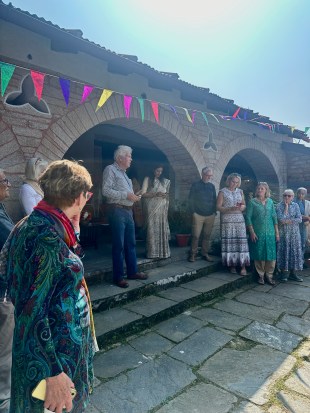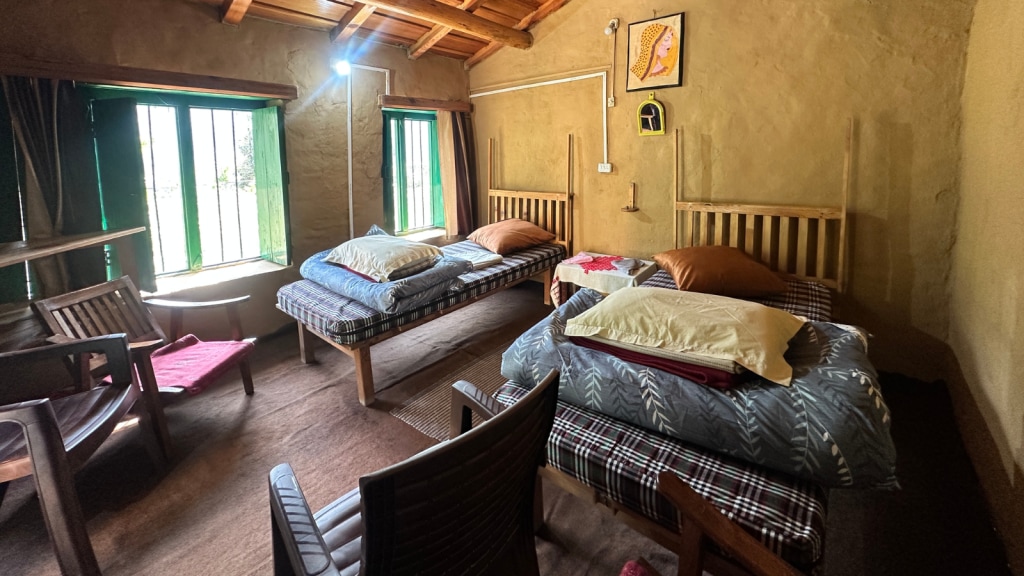High in the Kumaon Himalaya, where pine forests murmur with secrets of time and the snow peaks glow with dawn’s first light, lies Khali Estate—a colonial-era haven that has gracefully aged into a beacon of responsible tourism. This October, its 25-acre sprawl inside the Binsar Wildlife Sanctuary turned festive, as the estate marked two intertwined milestones: 150 years of Khali Estate and 20 years of Village Ways, the community tourism initiative that took root here and went on to transform the way India views travel and tourism.
Hosted by Manisha and Himanshu Pande, the wife-husband duo who have nurtured both the estate and the Village Ways movement, the event brought together villagers, guides, scholars, and old friends for “a day of shared stories, meals, and music.” It was not merely a celebration, but a reflection on how vision and conviction can shape a gentler future for tourism in India’s fragile mountain landscapes.
A Heritage Born of Vision and Solitude
Khali’s story begins in the late 19th century, when Sir Henry Ramsay, the legendary British administrator known as the “King of Kumaon,” built a home here amidst whispering pines and orchards of plum and peach. For Ramsay, who served as Commissioner of Kumaon and Garhwal, this land was more than a summer retreat—it was a vision of balance between man and mountain. He was succeeded by Mr. Wilson, who spent eight years expanding the residence, adorning it with granite walls, stately pillars, and pinewood floors that gleamed with warmth.
Over the decades, the estate became a sanctuary for thinkers and seekers. Mahatma Gandhi stayed here, establishing Shail Ashram—a spiritual and intellectual haven that endured for five years. The Nehru family too sought repose within its stone walls, the serenity of Binsar offering an escape from the churn of public life.
Today, as the golden dawn spills over the estate’s orchards and the snowy ridges of Trishul and Nanda Devi, the air still carries echoes of that contemplative past. But Khali is no museum—it is alive, evolving, and deeply intertwined with the story of a movement that began right here.
The Birth of Village Ways: A Dream Rooted in the Hills
When the Binsar Wildlife Sanctuary was created in 1988, it succeeded in protecting the region’s forests and wildlife—but at a human cost. Many villagers, restricted from their traditional forest-based livelihoods, were compelled to leave. Manisha and Himanshu Pande, for whom Khali was home, watched this quiet exodus with concern. Out of their desire to stem this tide of migration—and to bring dignity and opportunity back to local communities—was born the idea of Village Ways, the founders hailing from both India and the UK.
“We wanted to build a model where travel could support rather than disrupt village life,” recalls Manisha. In the early 2000s, they began working with a few nearby villages within the sanctuary to create community-run guesthouses, offering travellers a chance to walk between settlements, stay with local hosts, and experience Kumaoni life as it truly is.
That first experiment in Binsar grew organically into something much larger. Over the next two decades, Village Ways expanded to the Saryu and Pindar valleys, and then beyond Uttarakhand—to Madhya Pradesh, Chhattisgarh, Rajasthan, Kerala, and Karnataka. At every step, the principle remained unchanged: that tourism must sustain livelihoods, safeguard culture, and respect the environment.

The Celebration: Stories, Scholars, and Song
The 150/20 celebrations held on 23 October 2025 captured this spirit beautifully. The morning began with breakfast, followed by introductions on Khali’s sprawling sundeck and courtyard. The children of Khali Bhetuli School performed a welcome song that set a tone of warmth and belonging. Eminent historian Sri Shekhar Pathak, recipient of the Padma Shri, spoke about the layered history of Kumaon, drawing connections between ecology, migration, and cultural continuity. His talk was followed by Sri Harish Kapadia, the famed mountaineer and writer, who shared anecdotes from his explorations of the Kumaon Himalaya, particularly his expedition to the Nanda Devi Sanctuary. Later, the Village Ways guides and committee members took the stage, recounting their two-decade journey of learning and partnership—how they built trust, trained as hosts, and developed pride in their heritage. In the afternoon, Sri Ishwar Joshi, another chronicler of Kumaoni traditions, spoke about folk culture and the rhythms of rural life.
Khali Estate Today: Heritage Meets Hospitality
Beyond its historical gravitas, Khali Estate remains a living embodiment of Himalayan hospitality. Guests stay in the heritage bungalow—once Ramsay’s residence—where polished pine floors meet antique furniture and wide verandahs open to endless views of mountain silhouettes. For those seeking a closer communion with nature, the round cottages scattered through the estate offer conical wooden ceilings, cozy interiors, and windows that frame the Himalayas like a painting.
Dining at Khali is an experience in itself. The Pandes champion a farm-to-table philosophy: vegetables and herbs come from their own gardens, while much of the fruit is orchard-grown. Meals are unpretentious yet rich in flavour.

In the evenings, guests gather on the Sundowner Deck, a quiet space where the last light lingers over the ridges, and the silence is broken only by the call of a hill partridge or the rustle of wind in the deodars. There are no televisions, no distractions—just an invitation to slow down, breathe, and listen to the forest.
Village Ways: Redefining Responsible Travel
While Khali nurtures rest and reflection, Village Ways takes the experience outward—into the very heart of rural India. Each of its walking circuits is built around community-owned guesthouses, designed and managed by villagers themselves. Travellers walk ancient trails guided by locals who know every ridge and stream, pausing in villages where time still moves to the rhythm of the sun and the seasons.
The impact has been profound. Across its network of partner communities, Village Ways has:
- Created dignified livelihoods that allow people to remain in their ancestral villages.
- Strengthened local economies and infrastructure.
- Promoted gender equality by involving women in decision-making and hospitality.
- Revived traditional crafts, cuisine, and agriculture.
- Fostered environmental awareness among both hosts and guests.
Their model has earned national and international recognition—including awards for responsible tourism—but the true reward, as the Pandes often say, lies in “seeing communities flourish and guests return as friends.”
In an age of overtourism, Village Ways offers an antidote: travel that is intimate, mindful, and regenerative. Every journey is a partnership, every stay a cultural exchange, every meal a story.
A Living Legacy
The 150/20 celebrations at Khali Estate were more than an anniversary—they were a reminder of what endurance and empathy can achieve. Few places embody the continuum of history, nature, and human spirit as seamlessly as this estate in the clouds. From Sir Henry Ramsay’s colonial bungalow to Gandhi’s ashram and the Pandes’ vision of community-led tourism, Khali’s story is one of renewal through purpose.
In Manisha and Himanshu Pande’s stewardship, Khali Estate continues to be both a sanctuary and a seedbed—a place where the past and future meet quietly under the whispering pines, and where every guest departs with a piece of the Himalaya in their heart.


